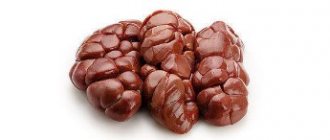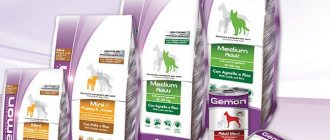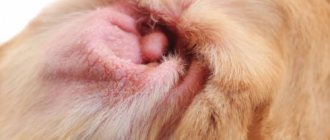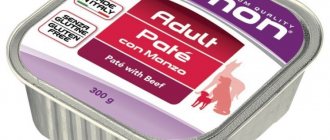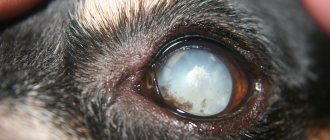Meat for dogs is the main and irreplaceable product in the four-legged diet. Meat is a source of protein, so necessary for the body of any predator. And as everyone knows, the distant ancestors of our beloved domestic animals were wolves.
Many dog owners, when switching their pet to natural feeding, including meat products in the diet, noted visible improvements in both the external and internal condition of the four-legged body: the coat became soft and shiny, allergic reactions and skin problems disappeared, the animal became energetic and active .
There are several theories about what kind of meat to feed a dog, in what form and how much of this product should be given to your pet.
What types of meat are best to give to a dog?
Many animal owners whose pets are naturally fed understand that meat must be present in the dog’s diet. But meat is far from the cheapest product, and not every owner can afford to buy expensive tenderloin or gourmet types of meat. And if the dog is also large in size, then this is generally noticeable on the wallet. So what kind of meat should you feed your dog? Let's figure this out.
Beef
Most often, dog breeders prefer beef. According to veterinarians, feeding an animal exclusively with beef tenderloin is not only not necessary, but even not advisable, since it does not contain all the microelements necessary for the pet’s body.
Parts of the carcass with vessels and veins, beef trim with cartilage and film are much more beneficial for the body, since cartilage and veins not only improve the quality of stool and prevent constipation, but also contain gelatin, which is so necessary for strengthening the bones and joints of the animal.
The main thing is that the beef is not very fatty. Beef by-products are also an integral part of the diet. They are rich in enzymes and nutrients.
It is not recommended to completely replace meat with offal and give it every day, since offal contains less protein and has low nutritional value. The amount of by-products should not exceed 15%-20% of the pet’s total meat diet
Offal can be used for feeding: sublingual part, cheeks, tails, peritoneum, offal, trachea, heart, udder.
Despite the fact that beef kidneys are one of the few by-products containing selenium, which has a positive effect on the functioning of the thyroid gland and normalizes the production of many hormones, it is still often not recommended to give them to the animal. The main harm lies in the high level of cholesterol in them, which clogs the blood vessels and the level of which in the kidneys is much higher than in the liver. And the specific smell, which is explained by the direct function of the organ, scares off many animal owners. If you want to pamper your pet with this product, then before giving it to your dog, soak the kidneys in water for 2-3 hours. This will get rid of the specific smell.
The liver and lung are on a separate list. These by-products cause stomach upset in many dogs. Therefore, they need to be introduced into the four-legged diet gradually, in small quantities, observing the body’s reaction.
Uncleaned beef stomach (tripe) is a special dish for dogs. In its raw form, it contains a huge amount of enzymes that improve digestion. There are many microorganisms in the rumen that heal the animal's intestinal microflora. I recommend reading up on what tripe is and what dishes you can prepare from it for your pet.
For more information about all the benefits of offal in the diet of our pets, read the article: what offal can be given to a dog.
Mutton
Lamb is a good alternative to beef. Lamb contains B vitamins necessary for strengthening muscle tissue. Lamb is also rich in potassium and magnesium, which have a positive effect on the cardiovascular system. Lamb fat has two times less cholesterol than beef.
horsemeat
Horse meat is also suitable for feeding dogs. Horse meat is rich in protein, digestible eight times better than beef and does not cause allergic reactions (unless individual intolerance to this type of meat is possible).
But it is not recommended to give horse meat to dogs often, since it is still dietary meat and contains very little fat, which is necessary for especially active and mobile animals.
In addition, the chemical composition of horse meat is such that it contains virtually no carbohydrates, which provides an excellent environment for the proliferation of dangerous bacteria. Therefore, if you are not 100% sure of the quality of the meat, then it is not recommended to give raw or undercooked horse meat to your pet.
Venison
When choosing between different types of meat, I would give preference to venison, which in my opinion is the best meat. It contains a large amount of vitamin B1, which saturates the body with energy, improves appetite, and reduces the risk of diseases of all internal organs of the animal. Venison is good for the heart muscle and gastrointestinal tract. The properties of venison meat are so unique that medicines are even made from it. But venison meat is considered a delicacy, and it is not so easy to find it in a regular market. And if you find it on sale, the cost of meat will be quite high. Therefore, if the dog owner is not a hunter, then few people will be able to often pamper their pet with this useful product.
Pork
There is a lot of debate about whether you can give your dog pork or not. The thing is that the body of these animals is designed in such a way that pigs eat everything, but during any, even the most active physical activity, they do not sweat at all, thereby retaining all harmful toxins inside the body.
Often, signs of the disease may not appear at all. But due to the lack of immunity, pigs are often carriers of diseases such as helminthiasis, toxocariasis, and tapeworm.
If you give your dog raw pork meat, you must be 100% sure of its quality.
I recommend reading up on whether you should give your pet pork and, if so, how often and in what form.
Rabbit meat
Rabbit meat is a leader in the content of vitamins and minerals. This meat contains vitamins B and C, nicotinic acid, iron, phosphorus, cobalt, potassium, fluorine and manganese. Due to the low sodium salt content, rabbit meat is a low-calorie, low-fat product. Including rabbit meat in your pet's diet will have a great effect on the functioning of the gastrointestinal tract.
But not all dogs can benefit from rabbit meat. If your pet has problems with the kidneys and biliary tract, then giving this type of meat to your pet is not recommended. The fact is that the structure of rabbit meat contains purine bases, which, when entering the animal’s body, are converted into uric acid, which diseased organs are unable to remove from the body. Crystals of unremoved uric acid accumulate and settle on tendons and joints, often leading to arthritis.
Poultry meat
Very often, dog owners include poultry in their pet's diet. The most common types of poultry meat that owners prefer to feed their dogs are chicken and turkey. The first is affordable, but the second is widely known for its valuable nutritional properties, but it also costs much more.
The main benefit of chicken meat is that, compared to other types of meat, it contains a lot of phosphorus and potassium. However, all the benefits of chicken meat are manifested exclusively in domestic chickens. If we talk about a product purchased in a store, then we are more likely to talk about the dangers rather than the benefits of chicken meat. Such meat contains a high level of antibiotics, as a result of which it often causes allergies in dogs.
If you feed your pet chicken, then you can read what parts of it and how to give it to your dog correctly in the material: Is it possible to feed a dog chicken meat.
Turkey meat is rich in vitamins A and E, calcium, potassium, magnesium and iron. The sodium content of turkey meat is higher than that of beef. Sodium normalizes the metabolic process in the body. Turkey meat is low in calories and, like rabbit meat, contains little fat and is easily absorbed by the body.
The living conditions and life expectancy of chickens and turkeys are different. Chickens raised on poultry farms for meat live for approximately no more than six months. All this time they are kept in cramped cages, and they are fed antibiotics for active growth.
A turkey can live several years to reach the required size. These birds are raised in spacious enclosures and in good conditions, otherwise these birds die quickly. Hence the differences in both the price and nutritional value of chicken meat and turkey meat.
Many followers of food systems for dogs that have been fashionable in recent years, such as the BARF nutrition system, claim that raw tubular bones from bird wings are not capable of harming the animal. Why?
The answer to this question can be found by reading about the RAW nutrition system for dogs.
How to diversify your diet?
In addition to red meat, your dog can and should be fed poultry meat (turkey, quail, day-old chicks, chicken, duck, etc.). However, such meat must first be prepared by removing all long bones from it, which can cause serious harm to the dog’s esophagus and stomach.
If the animal is good at chewing, then you can offer it a chicken back, bird neck and pectoral cartilage. This treat will not only please your pet, but will also help train its jaws.
Large dogs can be fed day-old and young gherkin chicks, even whole ones.
In what form should dogs be given meat?
What kind of meat should you feed your dog: raw or boiled? Animal owners' opinions on this matter vary.
Some people believe that raw meat is the healthiest for dogs. They claim that boiled meat does not bring any benefit, since heat treatment kills the most useful component of meat - protein, and that boiled meat is digested much worse than raw meat.
Others are categorically against feeding raw meat products, as they are convinced that raw meat can contain viruses, bacteria and parasites that can harm the health of the animal. There are often cases when raw meat is simply not accepted by the four-legged body.
In fact, heat treatment of products does not in any way affect the quality or digestibility of meat by the four-legged body. Thermally cooked foods are easily digested and do not impair the quality of the animal's stool.
The loss of the most valuable component of meat - protein, during heat treatment is only 2-7%. But even this percentage can be reduced if, when cooking meat, you put it in boiling water. The main destruction during cooking occurs in the amino acids contained in the meat. But if your pet’s diet is balanced, then all amino acids are easily replenished by including cottage cheese, sour cream, eggs, fish, vegetables, herbs and other healthy foods.
Many dog breeders believe that when feeding raw meat, a pet can easily become infected with salmonella, worms and other bacteria. Of course, there is always risk. But you need to know!
When dogs are fed natural raw food, the same as what predators eat in the wild, the stomach acidity of the animals is increased (about 4 times more than that of humans). And this is the norm. This acidic environment is necessary for the effective dissolution and digestion of raw meat and bone components. Increased acidity can destroy pathogenic bacteria such as salmonella, E. coli, and so on. Therefore, the danger of becoming infected with worms and other parasites when eating a raw food diet is minimal.
The dog's stomach is capable of digesting both raw and boiled meat. And both raw and boiled meat are very beneficial for the pet’s body.
Therefore, each dog owner decides for himself what meat to feed his four-legged dog. It is only important to adhere to the following rules:
- If you choose a raw diet, it will be better if you pre-freeze the meat in the freezer for 2-3 days.
- Before giving meat to a dog, it is advisable to pour boiling water over it.
- Do not buy untested meat. If you buy meat from a sick animal, even deep freezing will not kill the harmful bacteria in the contaminated meat. It is best to purchase meat products where there are quality certificates and sanitary documents.
Raw or cooked
Breeders argue for good reason: the health of their pets is in their hands. Raw meat, for example, beef, has many advantages over cooked meat. You shouldn’t go against nature, dogs are predatory animals. Unprocessed beef will benefit your pet. The main thing for the owner is to make sure of the quality of the product.
If in doubt or if it is impossible to constantly provide your pet with an unprocessed product, alternation is allowed. Two or three meals of raw meat per week is enough for your pet. The rest of the days let him eat boiled food.
Recommendations for feeding your dog meat
Here are some tips for dog owners:
- An adult dog should receive at least 50-60% meat from its entire daily diet. For sedentary and inactive animals, 15-20 grams per 1 kg of weight is enough. But active and energetic pets need about 30 grams per 1 kg of weight. This amount of meat should be given either in one or divided into 2 feedings, adding to other products.
- Your pet's diet should be balanced. You can't feed your dog just meat. This can lead to serious health problems. It is important that all the necessary substances are present in the four-legged body: both proteins and fats, carbohydrates and fiber. To do this, in addition to meat, it is important to include fish, eggs, dairy and fermented milk products, vegetables, herbs and fruits in your diet. After all, even the distant ancestors of our dogs, wolves, intuitively diversified their diet, eating roots and tops of plants, bird eggs or chicks, ears of rye or wheat, frogs, beetles, wild garden fruits, and even watermelons and melons.
- Introduce a new type of meat into your pet’s diet gradually, observing the body’s reaction: the condition of the stool and skin.
- To avoid parasite infection, deworm your animal regularly.
- The pieces should be of such a size that the dog does not swallow them immediately, but chews them, thereby naturally removing plaque.
- It is not recommended to give minced meat to dogs, as it is poorly absorbed by the body. It transits through the intestines, and the dog quickly becomes hungry. But, on your dog’s birthday, you can pamper your pet with a delicious meat cake made from minced meat.
- The amount of meat, as well as the portion of food in general, may vary depending on the time of year, physical activity and the state of the animal’s body. For example, in the summer, when it’s hot, a pet may eat less, but with active physical activity and sports training, the tail’s appetite improves. You must regulate your portion size yourself. The main criterion here is that food should not remain in the bowl. If after eating a dog leaves some of the food in the bowl, it is better to reduce the portion so that the animal does not overeat. And if a four-legged animal quickly eats everything and after that continues to “clank”, licking the empty bowl, then, most likely, it is not full. In this case, increase the serving size.
To summarize, I would like to say that when feeding a dog meat, the main thing is to make sure that the product has passed veterinary control and will not cause diseases or poisoning in the animal’s body.
Good luck to you! Take care of your pets!







